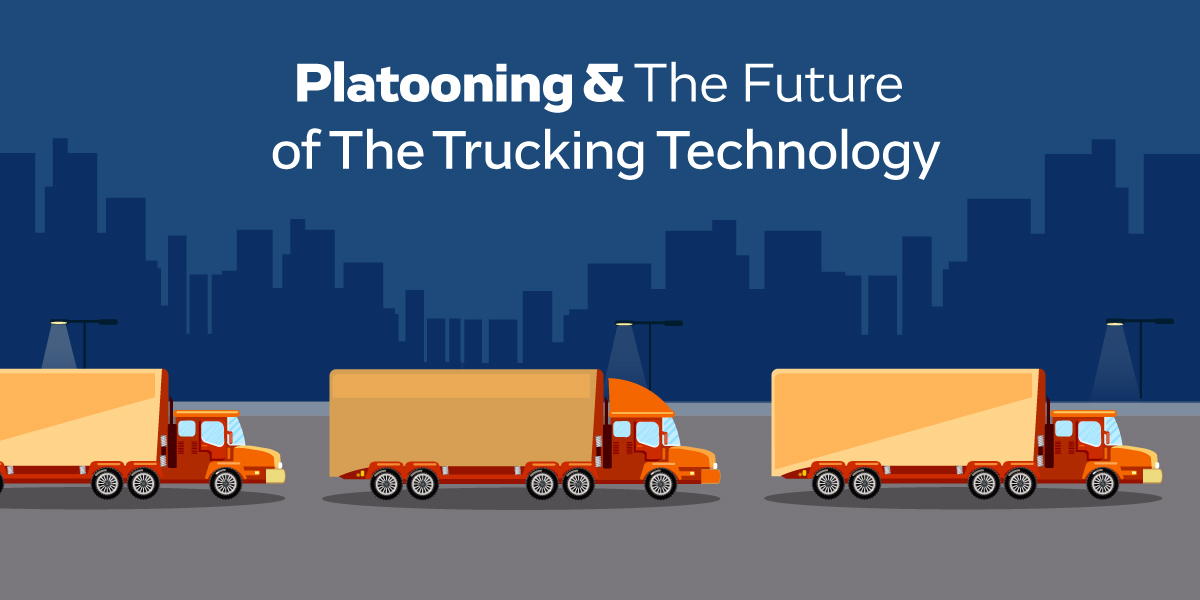Platooning & The Future of The Trucking Technology
The concept of truck platooning is steadily gaining traction in the transportation industry. With researchers, developers and industry experts projecting benefits such as increased fuel efficiency, decreased highway congestion and enhanced road safety, many companies are eager to explore the potential of platooning. Combined with the rise in automation technology, platooning practices could also mitigate the issue of labor shortages for trucking firms.
Over the last several years, vehicle manufacturers and transport research organizations in the United States and Canada have conducted both on- and off-road trials, with the results supporting platooning’s feasibility. While these trials have presented the benefits afforded to trucks already in platoon formation, the hurdle of how and when trucks will form convoys in the real world remains. Trucking firms will need the visibility of a collaborative logistics platform to fully unlock platooning’s viability and potential for efficiency.
To form a platoon, two or more tractor trailers are electronically linked through the use of Wi-Fi, radar and video monitoring. With a human driver on board acting as a “pilot,” the lead vehicle guides the platoon down the highway. Operated by advanced cruise control technology, the following trucks run a very short distance, usually 30 to 50 feet, in a line behind the leader. Real-time data communication enabled by advanced driving support systems permits the trucks to make immediate adjustments in speed and distance in response to sudden stops and movement changes. This technology creates a level of precision that a driver could not achieve alone.
The interest in platooning is primarily generated by its potential for fuel savings. Fluctuating diesel prices are a concern and tend to comprise a large portion of trucking firms’ operating costs. In fact, a recent article by The Washington Post estimated that up to 20 percent of American trucking companies’ expenditures can be attributed to fuel purchases. Truck platooning could easily and effectively alleviate some of this cost.
When a tractor-trailer drives at higher speeds, it experiences aerodynamic drag from the wind’s friction against the body of the vehicle, requiring increased fuel consumption to maintain speed. In a platoon formation, trucks increase their fuel efficiency with better aerodynamics and decreased drag. A 2014 study conducted by the National Renewable Energy Laboratory found that a platoon of two trucks generated an average of 7 percent fuel savings, with the lead truck saving 5.3 percent and the following vehicle 9.7 percent. Subsequent research in 2016 conducted by the North American Freight Council revealed similar findings, estimating the fuel savings of a two-truck platoon at 4 percent, taking into account traffic, terrain and overall time in platoon formation.
In addition to fuel economy boosts, advocates for platooning believe it will be able to reduce highway congestion by increasing road capacity and flow, benefiting both commercial and passenger vehicles. Decreased congestion means safer driving conditions for all and diminished carbon dioxide emissions for the environment. By maximizing road capacity and decreasing traffic jams, transport companies can cut down on delivery times and be more productive.
Another problem potentially alleviated by the adoption of platooning is the current driver shortage in the trucking industry. The American Trucking Associations (ATA) estimates a shortage of 38,000 drivers existed in the United States in 2014. The ATA also projects that by 2024 that number could grow to 175,000. Because researchers predict that the evolution of platooning will go hand in hand with automated trucking technology, firms may eventually not need as many drivers on the road to complete deliveries. Future platoons may only need a human driver to monitor the lead convoy, with the following vehicles operated by automated driving technology. In this scenario, more shipments could be made with fewer drivers involved. Some industry leaders also believe that this shift toward more flexibility in driver responsibilities could generate a new wave of interest in the profession.
When used in conjunction with today’s growing infrastructure of collaborative logistics technology, platooning could lead to even greater efficiencies in the freight and delivery process. If and when platooning becomes a common practice in the real world, trucking companies may not want to be limited to solely creating convoys of their own trucks. When there are multiple shipments traveling the same routes, they may need and want to collaborate with other firms to capitalize on the benefits of platooning.
As sources of real-time traffic, route and load data, collaborative logistics and freight exchange platforms could provide shippers, brokers and carriers the visibility they need to match trucks on the road with potential platoon pairings. In theory, this technology could identify platooning opportunities for a single truck to couple and decouple with others as it travels from the beginning to the end of its route. Platoon convoys could even potentially grow from just two trucks to multiple vehicles from different firms, and through this collaboration, each company could experience the benefits of fuel savings and maximized delivery capacity.
While there are still legislative roadblocks to overcome and technological advancements to be made before platooning can become a common practice, there is no doubt that, when combined with collaborative logistics, the possibilities for transport evolution seem endless.

